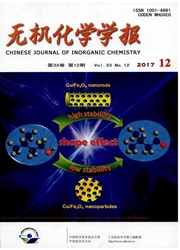

 中文摘要:
中文摘要:
本文报道了一种方便地构建铂/酞菁/碳纳米管fPt,Pc/CNTs)复合纳米催化剂的新方法:先通过简单的超声处理将酞菁分子骶)修饰至碳纳米管表面,随后采用乙二醇还原法将铂纳米粒子固载到酞菁修饰的碳纳米管表面,形成Pt/Pc/CNTs复合纳米催化剂。X射线衍射(XRD)和透射电镜(TEM)结果表明金属铂纳米颗粒均匀地分散在碳纳米管表面,尺寸约5nm。采用UV.Vis、mR和Raman等手段研究了这种复合纳米催化剂的构建过程,结果表明酞菁分子与碳纳米管之间存在较强的π-π相互作用,使其能牢固地吸附于碳纳米管表面。而酞菁分子能与Pt离子形成配合物的特性可能是最终形成高分散Pt纳米粒子的重要原因。酞菁分子的引入提高了铂纳米粒子在碳纳米管表面的分散程度。所得Pt/Pc/CNTs复合纳米催化剂呈现出比以未经修饰的碳纳米管负载的铂催化剂更高的甲醇电催化氧化活性。
 英文摘要:
英文摘要:
A method has been developed for the convenient construction of platinum/phthalocyanine/carbon nanotubes (Pt/Pc/CNTs) nanocomposite catalyst, i.e., CNTs were firstly decorated with phthalocyanine by ultrasonic treatment, then Pt nanoparticles were deposited onto their surface by ethylene glycol reduction. XRD and TEM characterization results indicated that metallic Pt nanoparticles with sizes of -5 nm were evenly distributed on the surface of CNTs. The constructing process of this nanocomposite catalyst was studied by UV- Vis, FTIR and Raman. It was revealed that Pc could be firmly adsorbed on CNTs due to the strong π-π interactions between them. As known, Pc could easily coordinate with Pt ions, which might be the main reason for the final high dispersion of Pt nanoparticles. This study indicates that the introduction of Pc molecules could effectively enhance the distribution of Pt nanoparticles on CNTs, and the so-constructed nanocomposite catalyst presents much better electrocatalytic property for methanol oxidation than the Pt nanocatalyst supported on pristine CNTs.
 同期刊论文项目
同期刊论文项目
 同项目期刊论文
同项目期刊论文
 Aligned ZnO Nanorods with Tunable Size and Field Emission on Native Si Substrate Achieved via Simple
Aligned ZnO Nanorods with Tunable Size and Field Emission on Native Si Substrate Achieved via Simple Aligned SiC Porous Nanowire Arrays with Excellent Field Emission Properties Converted from Si Nanowi
Aligned SiC Porous Nanowire Arrays with Excellent Field Emission Properties Converted from Si Nanowi Platinum/phthalocyanine/carbon nanotubes catalyst: Construction and electrocatalytic property for me
Platinum/phthalocyanine/carbon nanotubes catalyst: Construction and electrocatalytic property for me Six-Membered-Ring-Based Radical Mechanism for Catalytic Growth of Carbon Nanotubes with Benzene Prec
Six-Membered-Ring-Based Radical Mechanism for Catalytic Growth of Carbon Nanotubes with Benzene Prec Field Emission and Optical Properties of ZnO Nanowires Grown Directly on Conducting Brass Substrates
Field Emission and Optical Properties of ZnO Nanowires Grown Directly on Conducting Brass Substrates A general low-temperature CVD synthetic route to fabricate low-melting-point-metal compounds 1D nano
A general low-temperature CVD synthetic route to fabricate low-melting-point-metal compounds 1D nano Preparation and characterization of AlN-Based hierarchical nanostructures with improved chemical sta
Preparation and characterization of AlN-Based hierarchical nanostructures with improved chemical sta Evolution of aluminum nitride nanostructures from nanoflower to thin film on silicon substrate by di
Evolution of aluminum nitride nanostructures from nanoflower to thin film on silicon substrate by di Facile Construction of Pt-Co/CNx Nanotube Electrocatalysts and Their Application to the Oxygen Reduc
Facile Construction of Pt-Co/CNx Nanotube Electrocatalysts and Their Application to the Oxygen Reduc High-pressure pyrolysis of melamine route to nitrogen-doped conical hollow and bamboo-like carbon na
High-pressure pyrolysis of melamine route to nitrogen-doped conical hollow and bamboo-like carbon na Synergism of C5N six-membered ring and vapor-liquid-solid growth of CNx nanotubes with pyridine prec
Synergism of C5N six-membered ring and vapor-liquid-solid growth of CNx nanotubes with pyridine prec 期刊信息
期刊信息
